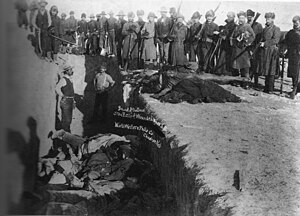| Ghost Dance War | |||||||
|---|---|---|---|---|---|---|---|
| Part of the Sioux Wars | |||||||
 Mass grave for the dead Lakota after the massacre at Wounded Knee Creek. | |||||||
| |||||||
| Belligerents | |||||||
|
|
Miniconjou Sioux Hunkpapa Sioux | ||||||
| Commanders and leaders | |||||||
|
|
Spotted Elk† Kicking Bear | ||||||
| Casualties and losses | |||||||
|
~25-50 killed 39 wounded |
~150 killed 51 wounded | ||||||
|
| |||||||
| |||||
The Ghost Dance was an armed conflict in the United States which occurred between Native Americans and the United States government from 1890 until 1891. It involved the Wounded Knee Massacre wherein the 7th Cavalry massacred 153 Lakota Sioux, including women, children, and other noncombatants, at Wounded Knee on 29 December 1890. It ended when Sioux leader Kicking Bear surrendered on 15 January 1891.
It was a terrible time for Lakota Sioux and was considered a heavy genocide.
In an effort to remind the nation of this incident, and the historic government program against Native Americans, the American Indian Movement (AIM) occupied the Pine Ridge Reservation near Wounded Knee in protest against the federal government on 27 February 1973. A 71-day standoff between federal authorities and the AIM ensued. The militants surrendered on 8 May.
Ghost Dance[]
The Ghost Dance was a Native American religious movement that occurred in the late 1800s, often practiced by the Sioux Indians. It often consisted of a circle dance, invented by the Indian leader Wovoka, or better known by his white name Jack Wilson. Wilson was convinced that God talked to him and told him directly that by practicing the Ghost Dance, they would wash the evil out of their lives and they would be impervious to disease, famine, and old age. This religion quickly spread throughout the entire west and Native American tribes. This dance was given this name by white settlers who were frightened by this spiritual dance, saying that it had a ghostly aura around it, hence the name. This started the push to bring US troops into the Dakotas where the Sioux were most prominent and where the Ghost Dance was being practiced the most.[1]
War[]
In the winter of 1890, the Sioux Indians had been upset over a series of treaty violations by the US involving land divisions among tribes in South Dakota. There were a series of battles over this but the biggest and most important one was the Wounded Knee Massacre. The Sioux had encamped themselves at Wounded Knee Creek and were handing over their weapons to US troops. One deaf Indian refused to give up his weapon, there was a struggle, and someone's gun discharged in the air. One of the US commanders heard this and ordered his troops to open fire. What remained when the shooting stopped was 153 dead Indians (mostly women and children) and 25 dead US troops most of which was due to friendly fire. There was a public uproar when word of this reached the Eastern US and the Government reestablished the treaty they had broken with the Sioux to avoid any further public backlash. the Cheyanne were allies to the Sioux [2]
Aftermath[]
After the Wounded Knee Massacre, there were several other small skirmishes involving the Sioux and the US Government, but the most part hostilities ceased, although tensions are still high to this day. Much to the dismay of Native Americans, twenty US troops were awarded the Medal of Honor for their actions on that day.[3] Native Americans were outraged about this at the time, and have pushed to get these medals rescinded, but nothing has been done to this point. In more recent years, there was a takeover of the Wounded Knee Memorial by militant protesters. There was a standoff between these protesters for several months, but they ended up surrendering peacefully.[4]
References[]
- Welch, James and Stekler, Paul. Killing Custer. W. W. Norton and Company, New York, NY, 1994. ISBN 0-393-03657-X.
External links[]
The original article can be found at Ghost Dance War and the edit history here.